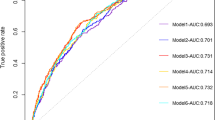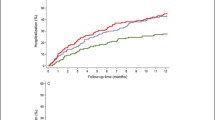Abstract
Background and aims
A multidimensional assessment representing overall lower- and upper-extremity performance is necessary to identify functional decline among older adults. The aim of this study was to develop and validate a physical performance scale (PPS) using both cross-sectional and observational approaches in older adults with and without community-based long-term care (LTC) needs in Japan.
Methods
A total of 416 community-living adults aged 75 years and over. The 7 items of the PPS include a range of physiological challenges, such as assessment of upper-extremity strength, lower-extremity strength, balance, and walking ability. Concurrent validity [correlating the PPS with self-reported functional status in activities of daily living (ADLs), instrumental ADLs, and Physical Function subscale of the Medical Outcomes Study 36-Item Short-Form Health Survey (SF-36PF)] and discriminative validity were assessed. Sensitivity to changes was evaluated with a 12-week exercise program.
Results
Total PPS score was significantly correlated with self-reported functional status such as ADLs, instrumental ADLs (IADLs), and SF-36PF (r = 0.53–0.62) and demonstrated no floor effect and minimal ceiling effect (8.7 %). The total PPS score showed large areas under the curve (AUC = 0.89; 95 % confidence interval, 0.86–0.92) with regard to discrimination between individuals with and without LTC needs. In observational analysis, total PPS score demonstrated small meaningful change in high-risk individuals requiring care (effect size 0.34).
Conclusions
The PPS may be a useful tool for identifying functional status decline and improvement in older adults requiring community-based LTC.


Similar content being viewed by others
References
Tamiya N, Noguchi H, Nishi A, Reich MR, Ikegami N, Hashimoto H, Shibuya K, Kawachi I, Campbell JC (2011) Population ageing and wellbeing: lessons from Japan’s long-term care insurance policy. Lancet 378(9797):1183–1192. doi:10.1016/S0140-6736(11)61176-8
Tsutsui T, Muramatsu N (2007) Japan’s universal long-term care system reform of 2005: containing costs and realizing a vision. J Am Geriatr Soc 55(9):1458–1463. doi:10.1111/j.1532-5415.2007.01281.x
Freedman VA, Martin LG, Schoeni RF (2002) Recent trends in disability and functioning among older adults in the United States: a systematic review. JAMA J Am Med Assoc 288(24):3137–3146
Cutler DM (2001) The reduction in disability among the elderly. Proc Natl Acad Sci USA 98(12):6546–6547. doi:10.1073/pnas.131201698
Tinetti ME (1986) Performance-oriented assessment of mobility problems in elderly patients. J Am Geriatr Soc 34(2):119–126
Guralnik JM, Branch LG, Cummings SR, Curb JD (1989) Physical performance measures in aging research. J Gerontol 44(5):M141–M146
Guralnik JM, Simonsick EM, Ferrucci L, Glynn RJ, Berkman LF, Blazer DG, Scherr PA, Wallace RB (1994) A short physical performance battery assessing lower extremity function: association with self-reported disability and prediction of mortality and nursing home admission. J Gerontol 49(2):M85–M94
Guralnik JM, Ferrucci L, Simonsick EM, Salive ME, Wallace RB (1995) Lower-extremity function in persons over the age of 70 years as a predictor of subsequent disability. N Engl J Med 332(9):556–561. doi:10.1056/NEJM199503023320902
Rantanen T, Guralnik JM, Foley D, Masaki K, Leveille S, Curb JD, White L (1999) Midlife hand grip strength as a predictor of old age disability. JAMA J Am Med Assoc 281(6):558–560
Al Snih S, Markides KS, Ottenbacher KJ, Raji MA (2004) Hand grip strength and incident ADL disability in elderly Mexican Americans over a seven-year period. Aging Clin Exp Res 16(6):481–486
Cesari M, Kritchevsky SB, Newman AB, Simonsick EM, Harris TB, Penninx BW, Brach JS, Tylavsky FA, Satterfield S, Bauer DC, Rubin SM, Visser M, Pahor M, Health A, Body Composition S (2009) Added value of physical performance measures in predicting adverse health-related events: results from the Health, Aging And Body Composition Study. J Am Geriatr Soc 57(2):251–259. doi:10.1111/j.1532-5415.2008.02126.x
Fried LP, Tangen CM, Walston J, Newman AB, Hirsch C, Gottdiener J, Seeman T, Tracy R, Kop WJ, Burke G, McBurnie MA, Cardiovascular Health Study Collaborative Research G (2001) Frailty in older adults: evidence for a phenotype. J Gerontol Ser A Biol Sci Med Sci 56(3):M146–M156
Sturnieks DL, St George R, Lord SR (2008) Balance disorders in the elderly. Neurophysiologie clinique Clin Neurophysiol 38(6):467–478. doi:10.1016/j.neucli.2008.09.001
Shimada H, Suzukawa M, Tiedemann A, Kobayashi K, Yoshida H, Suzuki T (2009) Which neuromuscular or cognitive test is the optimal screening tool to predict falls in frail community-dwelling older people? Gerontology 55(5):532–538. doi:10.1159/000236364
Stel VS, Smit JH, Pluijm SM, Lips P (2003) Balance and mobility performance as treatable risk factors for recurrent falling in older persons. J Clin Epidemiol 56(7):659–668
Hu MH, Woollacott MH (1994) Multisensory training of standing balance in older adults: I. Postural stability and one-leg stance balance. J Gerontol 49(2):M52–M61
Chaves PH, Garrett ES, Fried LP (2000) Predicting the risk of mobility difficulty in older women with screening nomograms: the Women’s Health and Aging Study II. Arch Intern Med 160(16):2525–2533
Studenski S, Perera S, Wallace D, Chandler JM, Duncan PW, Rooney E, Fox M, Guralnik JM (2003) Physical performance measures in the clinical setting. J Am Geriatr Soc 51(3):314–322
Kim MJ, Seino S, Kim MK, Yabushita N, Okura T, Okuno J, Tanaka K (2009) Validation of lower extremity performance tests for determining the mobility limitation levels in community-dwelling older women. Aging Clin Exp Res 21(6):437–444
Davis JW, Nevitt MC, Wasnich RD, Ross PD (1999) A cross-cultural comparison of neuromuscular performance, functional status, and falls between Japanese and white women. J Gerontol Ser A Biol Sci Med Sci 54(6):M288–M292
van den Brink CL, Tijhuis M, Kalmijn S, Klazinga NS, Nissinen A, Giampaoli S, Kivinen P, Kromhout D, van den Bos GA (2003) Self-reported disability and its association with performance-based limitation in elderly men: a comparison of three European countries. J Am Geriatr Soc 51(6):782–788
Kim MJ, Yabushita N, Kim MK, Matsuo T, Okuno J, Tanaka K (2010) Alternative items for identifying hierarchical levels of physical disability by using physical performance tests in women aged 75 years and older. Geriatr Gerontol Int 10(4):302–310. doi:10.1111/j.1447-0594.2010.00614.x
Kim MJ, Yabushita N, Kim MK, Nemoto M, Seino S, Tanaka K (2010) Mobility performance tests for discriminating high risk of frailty in community-dwelling older women. Arch Gerontol Geriatr 51(2):192–198. doi:10.1016/j.archger.2009.10.007
Kim MJ, Yabushita N, Tanaka K (2012) Exploring effective items of physical function in slow walking speed and self-reported mobility limitation in community-dwelling older adults. Geriatr Gerontol Int 12(1):50–58. doi:10.1111/j.1447-0594.2011.00726.x
Rossiter-Fornoff JE, Wolf SL, Wolfson LI, Buchner DM (1995) A cross-sectional validation study of the FICSIT common data base static balance measures. Frailty and injuries: cooperative studies of intervention techniques. J Gerontol Ser A Biol Sci Med Sci 50(6):M291–M297
Shinkai S, Watanabe S, Kumagai S, Fujiwara Y, Amano H, Yoshida H, Ishizaki T, Yukawa H, Suzuki T, Shibata H (2000) Walking speed as a good predictor for the onset of functional dependence in a Japanese rural community population. Age Ageing 29(5):441–446
Cohen J (1988) Statistical power analysis for the behavioral sciences, 2nd edn. Lawrence Erlbaum, New Jersey
Reuben DB, Siu AL (1990) An objective measure of physical function of elderly outpatients. The Physical Performance Test. J Am Geriatr Soc 38(10):1105–1112
Cress ME, Buchner DM, Questad KA, Esselman PC, deLateur BJ, Schwartz RS (1996) Continuous-scale physical functional performance in healthy older adults: a validation study. Arch Phys Med Rehabil 77(12):1243–1250
Sherman SE, Reuben D (1998) Measures of functional status in community-dwelling elders. J Gen Intern Med 13(12):817–823
McHorney CA, Tarlov AR (1995) Individual-patient monitoring in clinical practice: are available health status surveys adequate? Qual Life Res Int J Qual Life Aspects Treat Care Rehabil 4(4):293–307
Taekema DG, Gussekloo J, Maier AB, Westendorp RG, de Craen AJ (2010) Handgrip strength as a predictor of functional, psychological and social health. A prospective population-based study among the oldest old. Age Ageing 39(3):331–337. doi:10.1093/ageing/afq022
Rolland Y, Lauwers-Cances V, Cesari M, Vellas B, Pahor M, Grandjean H (2006) Physical performance measures as predictors of mortality in a cohort of community-dwelling older French women. Eur J Epidemiol 21(2):113–122. doi:10.1007/s10654-005-5458-x
Giuliani CA, Gruber-Baldini AL, Park NS, Schrodt LA, Rokoske F, Sloane PD, Zimmerman S (2008) Physical performance characteristics of assisted living residents and risk for adverse health outcomes. Gerontologist 48(2):203–212
Berg K (1989) Measuring balance in the elderly: preliminary development of an instrument. Physiother Canada 41(6):304–311
Seeman TE, Charpentier PA, Berkman LF, Tinetti ME, Guralnik JM, Albert M, Blazer D, Rowe JW (1994) Predicting changes in physical performance in a high-functioning elderly cohort: MacArthur studies of successful aging. J Gerontol 49(3):M97–M108
Perera S, Mody SH, Woodman RC, Studenski SA (2006) Meaningful change and responsiveness in common physical performance measures in older adults. J Am Geriatr Soc 54(5):743–749. doi:10.1111/j.1532-5415.2006.00701.x
Weening-Dijksterhuis E, de Greef MH, Scherder EJ, Slaets JP, van der Schans CP (2011) Frail institutionalized older persons: a comprehensive review on physical exercise, physical fitness, activities of daily living, and quality-of-life. Am J Phys Med Rehabil Assoc Acad Physiatr 90(2):156–168. doi:10.1097/PHM.0b013e3181f703ef
Taguchi N, Higaki Y, Inoue S, Kimura H, Tanaka K (2010) Effects of a 12-month multicomponent exercise program on physical performance, daily physical activity, and quality of life in very elderly people with minor disabilities: an intervention study. J Epidemiol Jpn Epidemiol Assoc 20(1):21–29
Acknowledgments
We are very grateful to the subjects for their enthusiastic participation during measurements. The study was supported by the Japan Society for the Promotion of Science (Grant-in-Aid for Scientific Research (A) # 19200047).
Conflict of interest
None.
Author information
Authors and Affiliations
Corresponding author
Appendix
Rights and permissions
About this article
Cite this article
Kim, M., Tanaka, K. A multidimensional assessment of physical performance for older Japanese people with community-based long-term care needs. Aging Clin Exp Res 26, 269–278 (2014). https://doi.org/10.1007/s40520-014-0230-2
Received:
Accepted:
Published:
Issue Date:
DOI: https://doi.org/10.1007/s40520-014-0230-2




